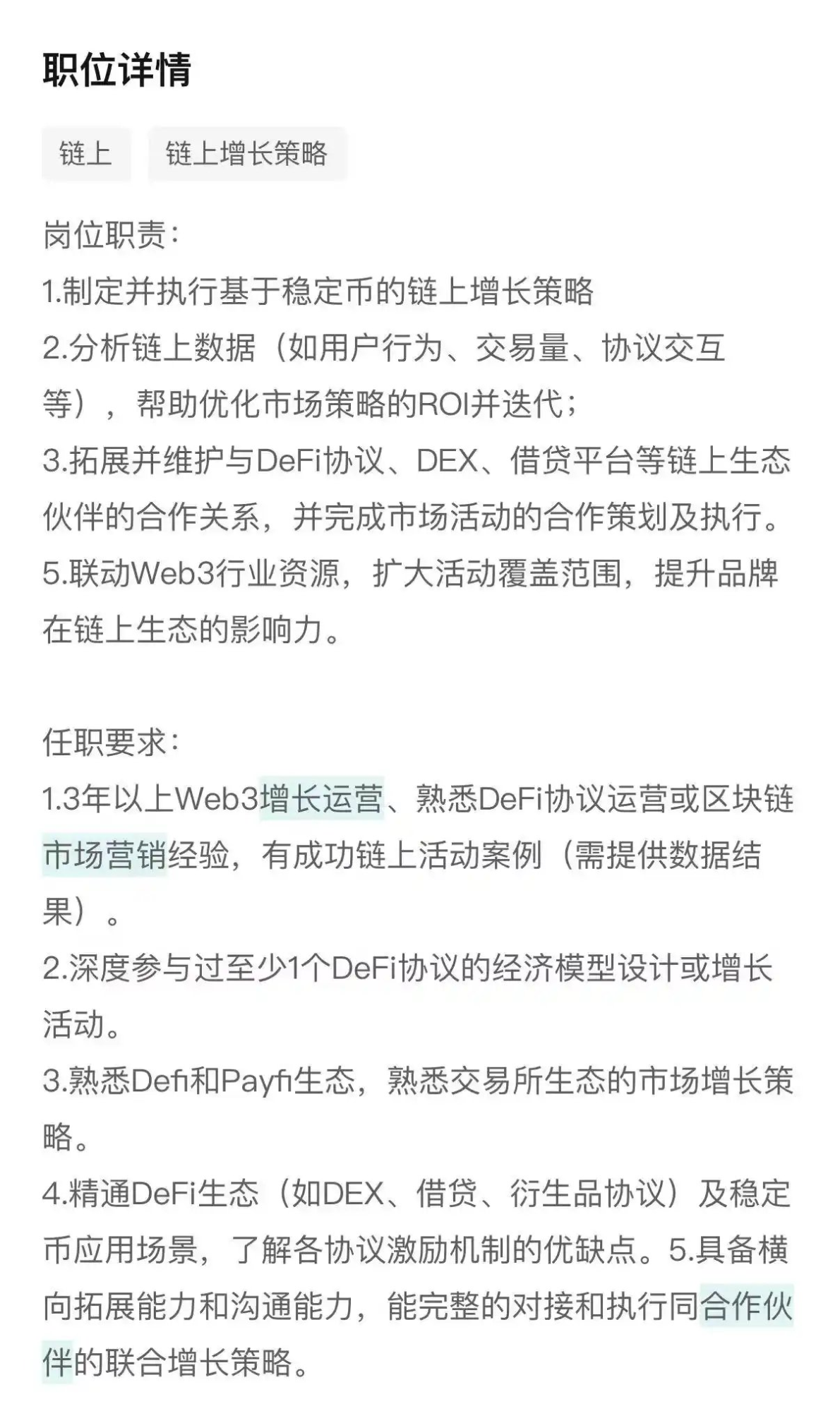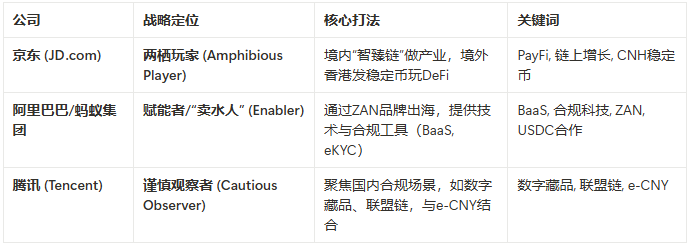JD.com seeks DeFi specialists: While stablecoins represent only the tip of the iceberg, PayFi lays out the blueprint for the industry’s deeper potential.
At times, a job listing can shed more light on a company's strategic direction than its annual report.
In August 2025, JD Technology issued just such a posting. Rather than appearing on major job boards, it quietly circulated within the Web3 community. The real headline wasn't the job title—“Stablecoin On-Chain Activity Planner”—but the “crypto-native” requirements: “Deep participation in at least one DeFi protocol’s economic model design” and “mastery of DEX, lending, and derivatives protocols.”

This wasn’t a search for a fintech expert to optimize in-house payments. JD was seeking a true on-chain strategist. When a major internet conglomerate with a market capitalization in the trillions, grounded in retail and supply chain, openly recruits talent fluent in decentralized ecosystems, the message is unmistakable: JD is moving its next piece onto the global, permissionless Web3 playing field.
Hong Kong’s Regulatory Tailwind—JD’s Strategic Entry
JD’s initiative didn’t happen in a vacuum. The timing of their hiring coincided perfectly with a critical regulatory shift in Hong Kong.
Just days before the job ad appeared—on August 1, 2025—Hong Kong’s long-awaited Stablecoin Issuer Licensing Regime took effect. After extensive consultation and sandbox trials, the HKMA rolled out a globally recognized compliance framework for stablecoin operators. JD’s recruitment is less blind exploration and more a calculated strategic move, taking aim at this newly sanctioned, high-value frontier in global finance.
Christopher Hui, Secretary for Financial Services and the Treasury in Hong Kong, has repeatedly stated: “Provided regulation and risk controls are in place, we support the prudent development of the virtual asset market and see stablecoins as a key bridge between traditional finance and virtual assets.”
For a tech firm like JD, with deep roots in Mainland China and global ambitions, this regulatory “tailwind” is perfectly timed. It delivers an ideal launchpad—a legal, geographic, and cultural stepping stone—to set up a compliant entity in Hong Kong. This allows JD to legally issue stablecoins pegged to fiat currencies (like offshore RMB (CNH) or HKD), bypassing strict mainland crypto rules and directly participating in the global on-chain economy.
The close timing of JD’s recruitment and the new regulations isn’t coincidence; this is a clear demonstration of strategic intent. JD clearly intends to participate, not simply observe.
PayFi: The “Financial Lego” That Transforms Payments
If Hong Kong’s regulatory environment is the strategic opening for JD’s stablecoin project, a single term in the job description—PayFi—reveals the core competitive edge and ambition behind it.
PayFi, short for Payment Finance, is a concept rooted in the crypto-native world. It goes far beyond “paying with crypto.” PayFi uses smart contracts to program payments, seamlessly connecting every transaction with advanced financial services.
Picture a JD supply chain scenario: A small supplier once waited up to 90 days for payment, straining their cash flow. Under PayFi, the process changes fundamentally.
After JD confirms delivery, the system generates an on-chain voucher (NFT or fungible token) representing the receivable and sends it instantly to the supplier. Instead of waiting 90 days, the supplier can immediately use the “digital promissory note” as collateral in DeFi lending protocols to access liquidity, or split and transfer it as payment to upstream suppliers. The entire workflow is executed automatically via code—efficient, transparent, and extremely low cost.
This is the combined power of Real World Asset (RWA) tokenization and PayFi, and it’s one of the hottest narratives in crypto for 2025. Jenny Johnson, CEO of Franklin Templeton, put it succinctly: “We believe tokenizing real-world assets will reshape the financial services industry. It’s one of blockchain’s most important applications.”
JD’s vast merchant network, complex supply chains, and hundreds of millions of users represent trillions in “real-world assets.” These include receivables, warehouse receipts, logistics orders, and consumer credit. Turning these assets into programmable on-chain value via stablecoins and PayFi opens up whole new channels for capital flows. This can deliver exponential gains. It’s not just efficiency for supply chain financing. It is a brand new programmable financial backbone.
Dual-Track Strategy: Divergent Web3 Plays from Chinese Giants
JD’s direct approach to stablecoins and DeFi carves out a distinct path among China’s tech behemoths exploring Web3. Comparing strategies paints a revealing landscape:

For example, Alibaba’s Ant Group acts as the “water seller” in the Web3 gold rush. Its Hong Kong-based ZAN brand focuses on compliance tech for Web3—e-KYC (digital identity), AML (anti-money laundering), and BaaS (blockchain-as-a-service). Ant’s strategy is enablement, supplying tools so others can “mine for gold,” rather than digging themselves. The recent push to integrate USDC with its proprietary chain confirms Ant’s preference for partnering with established ecosystems over building its own from scratch.
Tencent’s moves have been more cautious, anchored in consortium chains and digital collectibles—fields with clear domestic policy backing—while keeping a safe distance from the public-chain universe.
JD’s strategy stands out for its boldness and hybrid approach. Rather than just providing technology, JD pursues a dual-track strategy:
- Domestically: JD’s self-developed “Zhizhen Chain” focuses on industrial blockchain, serving anti-counterfeiting, digital evidence, compliance integration, e-CNY connections—strengthening the foundation for industry digitalization within regulatory limits.
- Offshore: JD uses Hong Kong as a springboard, becoming an active player—issuing its own stablecoin, building its own on-chain ecosystem, engaging directly with DeFi, and charting its own course for financial asset tokenization.
This dual-track approach secures compliance and stability at home, while opening JD’s future to global opportunity.
From E-Commerce Empire to On-Chain Economy
JD’s latest move marks a vital inflection point. It signals that top Web2 giants are moving beyond theoretical debate and small pilots, and are now integrating Web3 technologies into their core businesses.
Industry discussions have traditionally centered on the potential for Web3 to disrupt Web2. JD’s strategy points to another possibility: not so much disruption as “leveling up.” Web2 leaders aren’t being replaced; instead, they’re leveraging their massive user bases, rich scenarios, and deep capital to absorb Web3 technology and ideas, evolving into new, hybrid superpowers.
Challenges remain. JD must bridge technical integration, regulatory compliance, market education, and user behavior—moving from a single hire to building a thriving on-chain ecosystem. The company faces scrutiny from both traditional finance and crypto-native competitors.
But as JD—a major internet conglomerate with a market capitalization in the trillions—shifts toward DeFi’s deep waters, the entire industry should recognize this development. This isn’t just about JD’s future; it may offer a blueprint for how e-commerce empires leverage stablecoins to evolve into efficient, transparent, global on-chain economies.
Disclaimer:
- This article is reposted from [MarsBit]; copyright belongs to the original author [Luke, Mars Finance]. If you have any objections to the repost, please contact the Gate Learn team for prompt resolution according to standard procedures.
- Disclaimer: The views and opinions expressed herein are solely those of the author and do not constitute investment advice.
- All other language versions of this article are translated by the Gate Learn team, and may not be copied, distributed, or plagiarized without explicit reference to Gate.
Related Articles

Solana Need L2s And Appchains?

The Future of Cross-Chain Bridges: Full-Chain Interoperability Becomes Inevitable, Liquidity Bridges Will Decline

Sui: How are users leveraging its speed, security, & scalability?

Navigating the Zero Knowledge Landscape

What Is Ethereum 2.0? Understanding The Merge
